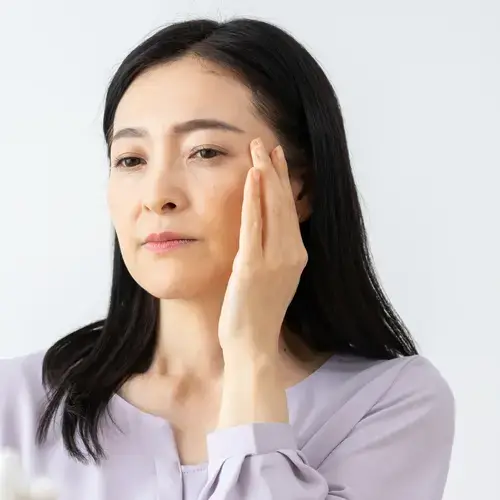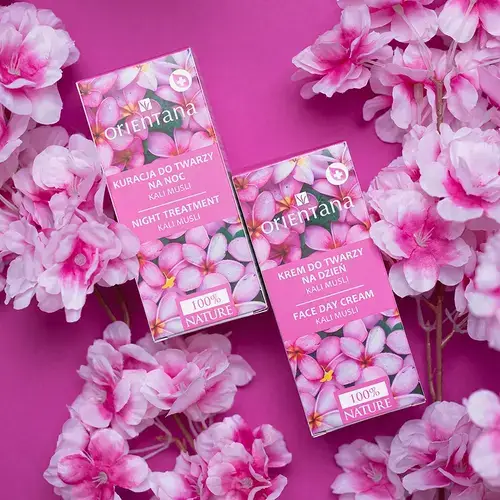What does dry skin look like?
Dry skin has several characteristic features that can be both visually noticeable and tactilely felt. Dry skin is a very characteristic type of skin. Its distinguishing feature is reduced sebum secretion.
Dry skin has a dull surface . It lacks natural shine and looks unhealthy. It can feel rough to the touch, especially on the elbows, knees and hands. Small, dry skin flakes are often visible, especially in areas exposed to external factors, such as the face and hands. Dry skin lacks firmness and wrinkles more easily.

Dry skin often looks delicate and thin, with visible blood vessels, especially on the cheeks. It may be red in places, which results from irritation and lack of proper hydration.
This type of skin can also be recognized by its feel. When dry, we feel tight. The skin can feel tight, especially after washing, when it lacks proper moisture. Dry skin is often itchy, which can be especially bothersome in cold, dry climates. It can be more sensitive to irritation caused by external factors, such as wind, cold, or using cosmetics.
This type of skin is easy to recognize, but unfortunately difficult to care for. Fortunately, in our offer you will find a wide selection of natural cosmetics that will help you deal with the problem of dry skin.
Where do we most often encounter dry skin problems? The face (especially the cheek area and forehead), hands, especially the backs of the hands, elbows, knees, calves and heels.
What are the causes of itchy skin?
Itching of the skin, known in medicine as pruritus (Latin: pruritus ), is a multifactorial symptom, the pathophysiological mechanism of which is complex and not fully understood. This process is the result of activation of specific nerve endings, called pruritic receptors, which are located in the epidermis and dermis. These impulses are conducted by C-type nerve fibers with low conduction velocity, which respond to a variety of chemical, mechanical, and thermal stimuli.
Itchy skin can be induced by:
- Inflammatory mediators – Histamine, released by mast cells in response to various allergic, infectious or mechanical factors, is one of the main mediators of itch (Steinhoff et al., 2006). It affects H1 receptors on nerve endings, causing the sensation of itch.
- Epidermal barrier dysfunction – Damage to the lipid barrier, characteristic of dry skin, leads to increased transepidermal water loss (TEWL) and exposure to irritants (Proksch et al., 2008).
- Pro-inflammatory cytokines – Interleukin-31 (IL-31) is one of the key mediators of itching in diseases such as atopic dermatitis (Szepietowski and Reich, 2016).
- Neuropathy – Dysfunction of peripheral nerves, such as in diabetic neuropathy, can lead to neuropathic itching.
In this post, we will describe how to care for dry skin caused by damage to the hydrolipid barrier.
HOW TO DEAL WITH DRY SKIN?
The basis of dry skin care is based on rebuilding the hydrolipid barrier, ensuring the right level of moisture and protection from external factors. The basis of dry skin care should of course be its regular hydration and moisturising. Remember to drink plenty of water (especially in summer!) and use cosmetics for dry skin that bind moisture in its cells - thanks to this, its natural protective barrier in the form of the hydrolipid coat will function properly. Maintaining the hydrolipid balance is the key to stopping excessive water loss from the skin and getting rid of recurring problems with dryness.
Regular moisturising also helps to rebuild the hydrolipid barrier. It is necessary to choose cosmetics with emollients – preparations containing lipids, humectants (e.g. glycerin or hyaluronic acid) and occlusive substances (e.g. shea butter). Emollients moisturise and strengthen the epidermal barrier and prevent water loss ( transepidermal water loss , TEWL). People with dry skin should choose cosmetics without added alcohol and irritants and apply creams and body butters after bathing to slightly damp skin to retain water in the epidermis.
WHAT ARE THE BEST COSMETICS FOR DRY SKIN?
Dry skin requires gentle cleansing. Avoid highly irritating face and body wash gels or milks. Choose mild SLS/SLES-free cleansers that do not damage the skin's lipid barrier. Avoid alkaline soaps that dry and irritate the skin. Wash your skin with lukewarm water, not hot water, to avoid drying out.
The best cosmetics for dry skin are intensively moisturizing preparations such as Serum Ampoule MOISTURIZATION with hyaluronic acid and trehalose. Snail Slime Essence will also work.

Use face creams that "repair" the hydrolipid barrier, protect against external factors and soothe redness and roughness. Kali Musli day cream and Kali Musli night cream will work well. Before the cream, apply a serum with ceramides.
For washing your face, we recommend Hello Dakty l.'s delicate but effective foam or gel.
Dry skin also needs exfoliation. However, it must be gentle exfoliation. Choose an enzymatic peel that will give good results but will definitely not irritate.

For your body, use natural butters such as Lemongrass Butter or Rose Butter , and once a week, do a full-body skin spa with Jasmine Butter - it is the best emollient.
WHICH COSMETICS ARE NOT SUITABLE FOR DRY SKIN?
In dry skin care, it is not recommended to use ingredients and cosmetics that can intensify dryness, irritate the skin or weaken its protective barrier. Avoid irritating or drying ingredients such as alcohols, especially denatured alcohol (Alcohol Denat.), Ethanol (Ethanol), Isopropanol (Isopropyl Alcohol), Methanol (Methanol) and Benzyl Alcohol (in higher concentrations ? These substances remove natural lipids from the skin, causing it to dry out and increase susceptibility to irritation.
Soaps and washing gels containing Sodium Lauryl Sulfate (SLS) and Sodium Laureth Sulfate (SLES) are strong detergents that disrupt the skin's hydrolipid layer and contribute to increased water loss through the epidermis.
Essential oils in large quantities (e.g. lemon oil, lavender) are also an inappropriate ingredient . They can cause irritation and allergies, especially on sensitive, dry skin.
Cosmetics with high concentrations of salicylic, glycolic and lactic acids. Although low concentrations of acids can be beneficial for dry skin, higher concentrations can lead to dryness and peeling, especially if the skin is already sensitive.
Another ingredient to avoid are astringents (astringents). Examples include menthol, camphor and sulfur. They are aggressive to the skin, which can intensify the feeling of dryness and irritation. Also avoid preservatives in high concentrations, e.g. parabens (Methylparaben, Propylparaben)Formaldehyde and their donors (e.g. DMDM Hydantoin, Imidazolidinyl Urea)
type of cosmetics that are not good for dry skin
Mattifying or anti-acne products - creams and toners intended for oily or combination skin often contain ingredients such as alcohol or high concentrations of acids that dry out the skin.
Mechanical peelings with large particles - strongly abrasive particles can damage the thin protective layer of dry skin, causing micro-damage and irritation.
Bar soaps - often contain high concentrations of alkaline detergents, which remove lipids from the skin's surface and contribute to its drying.
Cosmetics with a lot of foam - shower gels or facial washes that foam intensively often contain strong surfactants, e.g. SLS.
WHAT NOT TO FORGET WHEN CARE FOR DRY SKIN?
Dry skin care is not only about regular use of healthy and natural cosmetics for dry skin. It is also prevention. Therefore, try to avoid factors that contribute to dryness, especially chlorinated water and dry, air-conditioned rooms. We also advise against frequent and long exposure to the sun, it is better to give up sunbathing.
Take care of your home environment. Maintain the appropriate air humidity (40-60%) in rooms, especially during the heating season. Drink sufficient amounts of water (approx. 2 liters per day) to hydrate your body from the inside.
Sometimes a change in diet is needed. It is worth using a diet rich in vitamin E - it has antioxidant properties and supports skin regeneration. vitamin A - supports the reconstruction of the epidermis and omega-3 fatty acids, present in fish, nuts and vegetable oils.
Home remedies for dry skin
Home remedies for dry skin care can be an effective support, especially if used regularly and combined with a proper diet and protection from external factors.
Moisturizing your body and face with natural oils
Natural vegetable oils contain fatty acids and vitamins that support skin regeneration.
- Coconut oil – moisturizes, smooths and soothes irritations. Can be used on the whole body, especially on dry heels, elbows and hands.
- Almond oil – delicate, ideal for sensitive skin, moisturizes and soothes the feeling of dryness.
- Olive oil – rich in vitamin E, perfectly regenerates and nourishes.
- Avocado oil – deeply moisturises, especially useful for very dry skin.
How to use: Apply a small amount of oil to slightly damp skin after bathing. You can also add a few drops of oil to the bath water. Moisturizing your face with natural oils, such as Sandalwood Oil , which perfectly restores skin balance.
Moisturizing face masks made from food products
You can make your own moisturizing masks at home. Below are easy recipes.
Avocado and honey mask:
- Mash half an avocado and mix with 1 tablespoon of honey.
- Apply to face or dry body areas for 15–20 minutes, then rinse with lukewarm water.
- Effect: Moisturizing and nourishing the skin.
Yogurt mask:
- Mix 2 tablespoons of natural yogurt with 1 teaspoon of olive oil.
- Apply to skin for 10–15 minutes and rinse.
- Yogurt soothes irritations and olive oil moisturizes.
Moisturizing body baths with food products
These baths will help moisturize dry skin and provide relief from itchy skin.
Oatmeal bath:
- Pour a cup of ground oatmeal into a bathtub of warm water.
- Bathe for 15–20 minutes.
- Oats soothe, moisturize and relieve irritation.
Milk bath:
- Add 1–2 cups of full fat milk (or coconut milk) to the water.
- Milk proteins help soften skin and retain moisture.
Honey bath:
- Mix 2 tablespoons of honey with warm water in your bathtub.
- Honey has a moisturizing and regenerating effect.
Coconut oil bath :
- Dissolve coconut oil in warm bathtub water.
- Soak in the bath for 15–20 minutes.
- After bathing, gently pat your body dry with a towel to maintain the protective layer of oil.
Potato flour bath :
- Dissolve the potato flour in a small amount of warm water to create a slurry.
- Add the suspension to a tub of warm water. Step into the bath for 15–20 minutes.
- After bathing, rinse your body with lukewarm water.
Natural body scrubs
Gentle exfoliation of dry skin helps to get rid of dead skin and improves the absorption of nutrients. You can make your own body scrub.
Sugar scrub:
- Mix 2 tablespoons of sugar with 1 tablespoon of olive oil.
- Massage into skin using gentle, circular motions, then rinse.
Oatmeal scrub:
- Combine 2 tablespoons of oatmeal with 1 tablespoon of honey and 1 tablespoon of warm water.
- Gently apply to skin and massage for a few minutes.
Moisturizing with honey
Honey is a natural humectant, meaning it attracts moisture to the skin. Apply a thin layer of honey to dry areas (e.g. face, hands, elbows). Leave on for 15 minutes and rinse with lukewarm water.
Dry skin, if cared for and supported properly, will no longer cause us problems.






